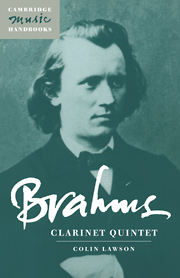Book contents
- Frontmatter
- Contents
- List of illustrations
- Preface
- 1 The nineteenth-century clarinet and its music
- 2 Brahms and the orchestral clarinet
- 3 Brahms's chamber music before 1891
- 4 The genesis and reception of the Clarinet Quintet
- 5 Design and structure
- 6 Performance practice
- 7 The legacy of Brahms's clarinet music
- Appendix 1 A list of Brahms's chamber music
- Appendix 2 A review of the first London performance,The Times,29 March 1892
- Appendix 3 The mechanism of Mühlfeld's Baermann-Ottensteiner clarinets
- Notes
- Select bibliography
- Index
3 - Brahms's chamber music before 1891
Published online by Cambridge University Press: 05 June 2012
- Frontmatter
- Contents
- List of illustrations
- Preface
- 1 The nineteenth-century clarinet and its music
- 2 Brahms and the orchestral clarinet
- 3 Brahms's chamber music before 1891
- 4 The genesis and reception of the Clarinet Quintet
- 5 Design and structure
- 6 Performance practice
- 7 The legacy of Brahms's clarinet music
- Appendix 1 A list of Brahms's chamber music
- Appendix 2 A review of the first London performance,The Times,29 March 1892
- Appendix 3 The mechanism of Mühlfeld's Baermann-Ottensteiner clarinets
- Notes
- Select bibliography
- Index
Summary
Aspects of style
Brahms was involved with chamber music from his childhood years. He played in a private subscription concert organised by his father as early as 1843, in which the programme included Beethoven's Quintet Op. 16 and one of Mozart's piano quartets. In 1851 two of his own chamber works were played at a private concert, and it was as a chamber music player and composer that Brahms introduced himself to Vienna in 1862 with the piano quartets Opp. 25 and 26. He continued to perform in this capacity, eventually partnering Mühlfeld in the clarinet sonatas at the end of his life.
Brahms's chamber masterpieces, listed in Appendix 1, began with the Piano Trio in B, Op. 8, whose first public performance took place in New York in 1855. Throughout Brahms's life, the traditional medium of chamber music was – paradoxically – often a vehicle for his newest ideas. In the early 1860s,
Brahms's strong concern with chamber music at this period of his creative life was partly a product of his profound disquiet at the stylistic developments of the ‘new German School’, particularly at the symphonic poems of Liszt. While chamber music had a traditional, even conservative, role in the genre-system of these times, it contained within itself an importantly progressive stylistic aspect. That ‘thematic density’ which formed one of the most significant stylistic continuities from Beethoven through Brahms to Schoenberg found its most characteristic home in chamber music; and the textural dialogue so fundamental to the genre, gave possibilities of great flexibility and intensity in thematic manipulation which were particularly congenial to Brahms.
- Type
- Chapter
- Information
- Brahms: Clarinet Quintet , pp. 21 - 30Publisher: Cambridge University PressPrint publication year: 1998



